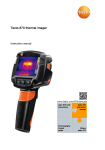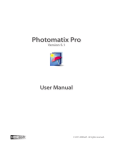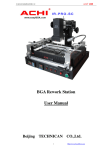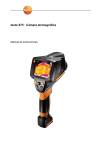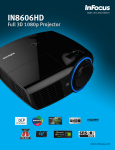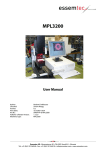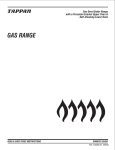Download Testo 875 Infrared Camera User Manual - Enviro
Transcript
testo 875 · Thermal imager Instruction manual 2 1 Contents 1 Contents 1 Contents ...................................................................................................3 2 Safety and the environment....................................................................4 3 4 5 6 2.1. About this document ........................................................................4 2.2. Ensure safety...................................................................................5 2.3. Protecting the environment..............................................................6 Specifications ..........................................................................................7 3.1. Use ..................................................................................................7 3.2. Technical data .................................................................................8 Product description...............................................................................12 4.1. Overview........................................................................................12 4.2. Basic properties.............................................................................13 First steps ..............................................................................................14 5.1. Commissioning ..............................................................................14 5.2. Getting to know the product...........................................................16 Using the product ..................................................................................21 6.1. Menu functions ..............................................................................21 6.1.1. 6.1.2. 6.1.3. 6.1.4. 6.1.5. 6.1.6. 6.1.7. 6.2. Measuring functions.......................................................................................21 Image gallery .................................................................................................23 Scale..............................................................................................................24 Display...........................................................................................................25 Emissivity.......................................................................................................25 Palette ...........................................................................................................28 Configuration .................................................................................................28 Measuring......................................................................................30 7 Maintaining the product ........................................................................32 8 Tips and assistance...............................................................................34 8.1. Questions and answers .................................................................34 8.2. Accessories and spare parts .........................................................35 3 2 Safety and the environment 2 Safety and the environment 2.1. About this document Use > Please read this documentation through carefully and familiarize yourself with the product before putting it to use. Pay particular attention to the safety instructions and warning advice in order to prevent injuries and damage to the products. > Keep this document to hand so that you can refer to it when necessary. > Hand this documentation on to any subsequent users of the product. Warnings Always pay attention to information that is marked by the following warnings with warning pictograms. Implement the specified precautionary measures. Representation CAUTION Explanation indicates circumstances that may lead to damage to the products Symbols and writing standards Representation Explanation Note: Basic or further information. 1. ... Action: more steps, the sequence must be followed. 2. ... 4 > ... Action: a step or an optional step. - Result of an action. ... Menu Elements of the instrument, the instrument displays or the program interface. [OK] Control keys of the instrument or buttons of the program interface. ... | ... Functions/paths within a menu. “...” Example entries 2 Safety and the environment 2.2. Ensure safety > Only operate the product properly, for its intended purpose and within the parameters specified in the technical data. Do not use any force. > Do not operate the instrument if there are signs of damage at the housing, mains unit or feed lines. The thermal imager must not be directed at the sun or other sources of intense radiation (e.g. objects with temperatures greater than 500 °C) during operation. This may lead to serious damage to the detector. The manufacturer accepts no warranty for this type of damage to the detector. > The objects to be measured or the measurement environment may also pose risks: Note the safety regulations valid in your area when performing the measurements. > Do not store the product together with solvents. Do not use any desiccants. > Carry out only the maintenance and repair work on this instrument that is described in the documentation. Follow the prescribed steps exactly. Use only original spare parts from Testo. > Improper use of rechargeable batteries can lead to destruction or injuries by means of current surges, fire or escaping chemicals. The following instructions must be observed to avoid such hazards: • Only use in accordance with the directions in the instruction manual. • Do not short, take apart or modify. • Do not expose to heavy impacts, water, fire or temperatures above 60 °C. • Do not store in the proximity of metal objects. • Do not use leaky or damaged rechargeable batteries. In the event of contact with battery acid: Thoroughly wash affected area with water and consult a doctor, if necessary. • Only charge in the instrument or the recommended charging station. • Immediately stop the charging process if this is not completed in the given time. 5 2 Safety and the environment • 2.3. In the event of improper function or signs of overheating, immediately remove the rechargeable battery from the measuring instrument/charging station. Caution: Rechargeable battery may be hot! Protecting the environment > Dispose of faulty rechargeable batteries/spent batteries in accordance with the valid legal specifications. > At the end of its useful life, send the product to the separate collection for electric and electronic devices (observe local regulations) or return the product to Testo for disposal. 6 3 Specifications 3 Specifications 3.1. Use The testo 875 is a handy and robust thermal imager. It opens the door to contactless determination and illustration of the temperature distribution on surfaces for you. Typical areas of application are: • Building inspection (heating, ventilation and air conditioning trade, company technicians, engineering offices, experts): Energy evaluation of buildings • Preventative maintenance (servicing): Mechanical and electrical inspection of systems and machines • Production monitoring (quality assurance): Monitoring production processes The testo 875 is available in several versions, which are tailored to various usage requirements: • testo 875-1: High-quality wide-angle lens 32° x 23, detector 160 x 120, manual focus, 2 GB SD card for approx. 1000 images, minimum focus distance 10 cm • testo 875-2: High-quality wide-angle lens 32° x 23, detector 160 x 120, manual focus, 2 GB SD card for approx. 1000 images, minimum focus distance 10 cm, integrated digital camera, exchangeable lens, display of surface moisture distribution Export control Thermal imagers may be subject to the export restrictions of the European Union. Please observe the national regulations for export control when exporting. 7 3 Specifications 3.2. Technical data Infrared image output Characteristic Values Field of vision/min. focusing distance Standard lens: 32° x 23°/0.1 m (0.33 ft) Thermal sensitivity (NETD) < 110 mK at 30 °C (86 °F) testo 875-2 only (optional): Telephoto lens: 9° x 7°/0.5 m (1.64 ft) Geometric resolution Standard lens: 3.3 mrad Telephoto lens: 1 mrad Refresh rate 9 Hz Focus manual Detector type FPA 160 x 120 pixels, a.Si Spectral range 8 - 14 μm Visual image output (testo 875-2 only) Characteristic Values Field of vision/min. focusing distance 33° x 25°/0.4 m (1.31 ft) Image size 640 x 480 pixels Refresh rate 8 to 15 Hz Image presentation Characteristic Values Image display 3.5" LCD with 320 x 240 pixels Display options testo 875-1: Infrared image testo 875-2: Infrared image/real image/infrared and real image 8 Video output USB 2.0 Video stream 9 Hz Colour palettes 4 options 3 Specifications Measuring Characteristic Values Temperature range (can be changed) -20 - 100 °C/0 - 280°C (-4 - 212 °F/32 536°F) Accuracy ±2 °C (±3.6 °F) or ±2 % of reading (whichever is the greater) Reproducibility ±1 °C (±1.8 °F) or ±1 % (whichever is the greater) Measuring point minimum diameter Standard lens: 10 mm at 1 m On-time (time to image) 30 s Measuring functions Standard measurement (1-point), Cold-/ Hotspot Telephoto lens: 3 mm at 1 m testo 875-2: Display of the surface moisture distribution via manual entry of the dewpoint Compensation for manual reflected temperature Setting emissivity 0.01 - 1.00 Image storage Characteristic Values File format .bmt Export options in .bmp, .jpg, .csv Removable memory SD card Memory capacity Scope of delivery: 2 GB (approx. 1000 images) Lens Characteristic Values Standard lens 32° x 23° Telephoto lens (testo 9° x 7° 875-2 optional) Aperture 1.0 9 3 Specifications Power supply Characteristic Values Battery type Fast-charging, Li-ion battery can be changed on-site Operating time approx. 4 h at 20 - 30 °C (68 - 86 °F) Charging option In instrument/in charging station (optional) Mains operation Yes, with mains unit 0554 8808 Mains unit output voltage 5 V/4 A Ambient conditions Characteristic Values Operating temperature -15 - 40 °C (5 - 113 °F) Storage temperature -30 - 60 °C (-22 - 140 °F) Air humidity 20 - 80 %RH, not condensing Enclosure rating of the housing IP54 (Interface terminals closed, battery connected, lens mounted) Physical features 10 Characteristic Values Weight 900 g (including battery) Dimensions 152 x 108 x 262 mm (5.98 x 4.17 x 10.31") Tripod mounting Yes, with adapter (included in delivery) Housing ABS Protection class IP 54 Vibration max. 2 G 3 Specifications PC software Characteristic Values System requirements Operating system Windows XP Service Pack 2 or Windows Vista USB 2.0 interface Standards, tests, warranty Characteristic Values EU Directive 2004/108/EC Vibration IEC 60068-2-6 Warranty 2 years, warranty conditions: see website www.testo.com/warranty 11 4 Product description 4 Product description 4.1. Overview Product components 1 Display. 2 Control keys: Key Functions [ Switch the imager on/off. ] [OK] and Joystick Press [OK]: Open menu, confirm selection/setting. • Move [OK] up/down/right/left = Joystick function: Select functions, navigate [Esc] Cancel action. Left/right ["xy"] quick select button Call up a function. The function assigned to the quick select button at any one time is shown in the display. 3 12 • Instrument rechargeable battery lock release button. 4 Product description 4 Metric thread: For fastening the included tripod adapter. Do not use desktop tripods, danger of tilting! 5 Right interface terminal: Not assigned 6 Digital camera lens: For recording visual images (testo 875-2 only) 7 Infrared camera lens: For recording thermography images. Exchangeable lens (testo 875-2 only). 8 Rotating ring Manual focusing: For focusing manually. 9 Lens lock ring 10 [Trigger]: For recording (freezing/saving) images. 11 Left interface terminal: Memory card slot. USB interface. Mains socket, for connecting the included mains unit. Buffer battery slot. 12 Status LED: off (no mains unit connected), flashes (mains unit connected and rechargeable battery charging), lights up (mains unit connected and battery charging process completed). 4.2. Basic properties Voltage supply The power is supplied to the instrument via an exchangeable rechargeable battery or via the included mains unit. With an attached mains unit, the power is supplied automatically via the mains unit and the instrument's rechargeable battery is charged (only at ambient temperatures from 0 to 45 °C). Charging the battery is also possible using a desktop charging station (accessory). The instrument is equipped with a buffer battery (type CR 1632) to maintain the system data during an interruption in the power supply (e.g. when the battery is changed). File formats and file names The images are saved according to the following pattern: XX_YYYYY.ZZZ XX: IR for infrared image without attached real image, IV for infrared image with attached real image, VI for real image. YYYYY: 5-digit consecutive number ZZZ (file extension): BMT for infrared image without/with attached real image, BMP for real image. 13 5 First steps 5 First steps 5.1. Commissioning Connect rechargeable battery The imager is delivered with a rechargeable battery that is inserted in the rechargeable battery slot but not connected. > Push the battery all the way into the rechargeable battery slot until this is flush with the bottom of the handle. T h e thermal imager starts automatically. Perform basic settings > Remove the protective film from the display. - The start screen appears on the display. - The Landeseinstellungen (Country settings) dialogue is opened. Instrument language (Language) and temperature unit (Unit) can be set. 1. Move Joystick up/down to select the desired option. - The selected option has an orange border. 2. Confirm the selection with [OK]. - The selected setting is highlighted orange ( ). The arrows ( ) show that the setting can be changed. 3. Move Joystick up/down to change the setting. 4. Confirm the entry with [OK]. 5. Confirm the settings with Übernehmen (Apply). 6. Press [ 14 ] to switch off the thermal imager. 5 First steps Initial charging of rechargeable battery The thermal imager is delivered with a partially charged battery. Completely charge the battery before use. > Connect the country-specific adapter required for the existing mains to the mains unit. 1. Open the cover on the left side of the thermal imager (1). 2. Connect the mains unit to the mains socket ( ) (2). 3. Connect the mains plug to a mains socket. - The thermal imager starts automatically. When charging the rechargeable battery, the imager can remain switched on or be switched off. This has no effect on the length of the charging process. - The charging of the rechargeable battery begins. - The charge status is indicated on the status LED: • LED flashes: Charging in process. • LED lights up: Battery charged, charging process finished. 4. Charge the rechargeable battery completely, then disconnect the instrument from the mains unit. - After the initial charging of the battery, the thermal imager is ready for operation. Charging the battery is also possible using a desktop charging station (accessory). 15 5 First steps 5.2. Getting to know the product Insert the memory card 1. Open the cover on the left side of the thermal imager. 2. Insert memory card (SD card) into the card slot (SD) (1). > To remove the memory card: Press on the memory card to release the lock. Mount/remove infrared protection glass Installation: 1. Attach the protection glass fastened to the red mounting ring to the lens and turn the mounting ring clockwise to the stop. 2. Remove the red mounting ring from the protection glass. Removal: 1. Attach the red mounting ring to the protection glass. 2. Turn the mounting ring anticlockwise and remove the protection glass. After mounting/removing the protection glass, activate or deactivate the Protection glass option, Optics... page 29. If this option is set incorrectly, the stated measuring accuracy is not guaranteed. Mount tripod adapter Using the included tripod adapter, the imager can be fastened to the testo tripod (accessory) or to a commercially available standard tripod. With the tripod adapter mounted, the battery cannot be changed! 1. Place the tripod adapter on the lower end of the handle and screw on using the included Allen key (ISO 2936, size 4). 2. Slide thermal imager into the fastening plate of the testo tripod and lock or fasten it to the commercially available standard tripod (screw-type fastening). 16 5 First steps Mount Sun Shield The Sun Shield increases the readability of the display with a high exposure to light. > Set the Sun Shield on the thermal imager from above (1) and pull both sides of the Sun Shield down around the display (2). Mounting Softcase The Softcase combines the functions of instrument protection, Sun Shield and carrying function (strap). 1. Set the Softcase on the imager from above (1) and pull both sides of the Softcase down around the display (2). 2. Guide Velcro strip through the two plates (3) and close (4). Changing lens (testo 875-2 only) Only lenses that were adjusted to the respective thermal imager can be used. The serial number on the lens must match the serial number of the instrument, see Optics... page 29. > Switch instrument off before changing the lens. > To keep the lens from falling out: Hold the instrument with the lens pointing up. 1. Turn lens lock ring anticlockwise to the stop (approx. 2 cm). 17 5 First steps 2. Remove lens. 3. Insert new lens, taking care to align the white markings on the lens and the instrument with one another. 4. Turn the lens lock ring clockwise to the stop. Always store lenses not in use in the container designed for this in the case. > Turn the lens ring clockwise to the stop, place the lens in the container and close it. Switch the imager on/off 1. Remove protection cap from the lens. 2. Press [ ]. - The start screen appears on the display. The type designation of the imager and the firmware version are shown. - The measurement view is opened after the warm-up period. - The imager performs an automatic zeroing approx. every 60 sec. This can be recognized by means of a "click". The image is frozen briefly when this occurs. > To switch off: Press [ - ]. The display goes out and the imager is switched off. Manually focusing the image > Turn Rotating ring of the lens until the image is in focus. Record (freeze/save) image 1. Press [Trigger]. - The image is frozen (fixed image). If the image is to be saved, the desired storage location can be set using the left [Folder] quick select button, see Select the storage location (folder): page 31. testo 875-1: • Infrared image is shown: Infrared image is saved. testo 875-2: 18 • Infrared image or infrared/real image is shown: Infrared image is saved, real image is saved in the same file as an attachment to the infrared image. • Real image is shown: Real image is saved. 5 First steps 2. Save image: Press [Trigger] again, or: Press [OK]. or Discard image: Press [ESC]. Getting to know the quick select buttons The quick select buttons can be assigned functions that are required often so that you can call them up directly. Factory settings: • Left quick select button: [Scale]. • Right quick select button: [Palette] (testo 875-1) or [Image type] (testo 875-2). Changing assignment of the quick select buttons 1. Move Joystick left or right to open the Configure key function list for the left or right quick select button. 2. Move Joystick up/down to select the desired function. Function Description Image type (testo 875-2 only) Change display mode: Infrared image, real image or infrared/real image. 1 Palette Change colour palette for the infrared image. Emissivity... Set emissivity and reflected temperature. Scale... Set scale limits. Adjustment Perform manual zero point calibration. 3. Press [OK] to activate the selected function. 1 Real image and infrared lens have a different angle of view due to the spacial separation. The image areas therefore do not correspond completely (parallax error). 19 5 First steps Navigating in the menu 1. Press [OK] button. - The Menu is opened. 2. Select navigation/function: - 20 • Move Joystick up or down to select the menu item. • Press [OK] to confirm the selection. Or for menu items that are marked with an arrow (►): Move Joystick to the right. • Move Joystick to the left to return to the previous menu level. • Press [OK] to select the function. • Press [ESC] to cancel the process and change to Measuring Mode. Depending on the selected menu item, press [OK] to perform a setting or open a submenu/dialogue, see Menu functions page 21. 6 Using the product 6 Using the product 6.1. Menu functions 6.1.1. Measuring functions 1-point measurement The 1-point measurement is the standard measuring function. If this is activated ( ), all available options can be selected via the quick select buttons. > [OK] | Measurement | [OK] | 1-point measurement | [OK]. testo 875-2 only: If the 1-point measurement is activated, the crosshairs can be moved using the Joystick on frozen and saved images to read off the individual temperatures. With saved images, the 1-point measurement must be activated via the menu for the respective opened image. Cold-/Hotspot Cold-/Hotspot shows the minimum and maximum temperature ), the quick point on the display. If Cold-/Hotspot is activated ( select buttons with the Coldspot and Hotspot functions can be permanently assigned and can no longer be changed. With frozen images, the crosshairs can be moved and the min./max. point is visible. The min./max. point is not saved. With saved images, Cold-/Hotspot must be activated for the respective opened image. > [OK] | Measurement | Cold-/Hotspot | [OK]. > Select left or right Coldspot or Hotspot quick select button to activate/deactivate the respective function. 21 6 Using the product Humidity (testo 875-2 only) The surface humidity is calculated using the manually entered dewpoint temperature and the measured surface temperatures. In the display, the areas that are at risk of developing mould are shown using a special colour palette: Colour Surface moisture Assessment green 0…64% noncritical yelloworange 65…80% potentially critical red >80% critical If this function is activated ( ), the quick select buttons are permanently assigned the Dewpoint and Emissivity... functions. The dewpoint temperature is shown at the upper edge of the display. 1. [OK] | Measurement | [OK] | Humidity | [OK]. - The Dewpoint dialogue is opened. The dewpoint temperature can be entered. In addition, the values for ambient temperature and ambient humidity can be entered for informational purposes (evaluation by means of IRSoft software). 2. Move Joystick up/down to select the desired option. - The selected option has an orange border. 3. Confirm the selection with [OK]. - The selected number is highlighted orange. 4. Move Joystick up/down to set the desired value. Move Joystick right/left to change between the numbers. 5. Confirm the entry with [OK]. 6. Confirm the settings with Apply. Measuring range The measuring range can be set to adapt to the respective area of application. 1. [OK] | Measurement | [OK] | Measurement range. 2. Select the desired temperature range and confirm with [OK]. Depending on the scene temperature, the measuring range may be undershot or exceeded. In this case, --- or +++ is shown instead of the readings. > If this occurs, change the measuring range. 22 6 Using the product 6.1.2. Image gallery Show images… 1. [OK] | Image gallery | [OK] | Show images… | [OK]. - The Folder dialogue is opened. - The folder name of the opened folder is displayed in the header. ROOT designates the base folder (top level). - The saved data is shown as preview images (image overview). The image saved last is shown directly behind the folders. Optional: > Press the right [Page scroll] quick select button to change to page scroll. In page scroll, you can navigate in groups of 3 x 3 images/folders (page by page). To select/open an image/folder, you must change back into Single Image. 2. Navigate: • In page scroll: Move Joystick up/down to change between the pages. • In single image: Move Joystick up/down/left/right to select a preview image/a folder (orange border). • Open selected folder with [OK]. 3. In single image: Press [OK] to open selected preview image. Press Gallery to return to the image overview. Delete image 1. In single image: Select image (orange border) or select and open image. 2. Press Delete to delete the selected or open image. - A confirmation request appears as to whether the image should really be deleted. 3. Confirm with [OK] or cancel process with [Esc]. Create new folder 1. In the Folder dialogue: Select New Folder with the joystick and confirm with[OK]. - The Folder name dialogue is opened. 2. Name folders: Use the Joystick to select the desired letters and confirm with[OK]. 23 6 Using the product The folder name can consist of up to 8 characters. Incorrect entries can be deleted using the right [◄C] quick select button. 3. Press left [Create Folder] quick select button to create the folder. Erase all 1. [OK] | Image gallery | [OK] | Erase all… | [OK]. - A confirmation request appears as to whether all files on the memory card should be deleted. Folders are not deleted. 2. Confirm erase with [OK] or cancel process with [Esc]. 6.1.3. Scale... Set scale limits You can choose between auto-scaling (continuous, automatic adjustment to the current min./max. values) and manual scaling. The scale limits can be set within the activated measuring range (see Measuring range page 22). All temperatures that undershoot or exceed the limit value are shown in the colour of the limit value (depending on the selected colour palette, see Palette page 28). Temperature ranges that are not relevant can thus be hidden. 1. [OK] | Scale… | [OK]. - The Set scale dialogue is opened. 2. Move Joystick left/right to select the desired option: Autoscaling ( ), min. value ( ), temperature range ( ) or max. value ( ) - The selected option has an orange border ( ). 3. With the selection of min. value, temperature range or max. value: Move Joystick up/down to change the value(s). - Changes are applied immediately so that the effects on the display of the infrared image can be checked directly. 4. Close dialogue with [OK] or [Esc]. - 24 The changes are saved. 6 Using the product 6.1.4. Display... Select display options The presentation can be adapted by means of showing/hiding the following elements: Crosshairs, temperature scale and quick select buttons. Hidden function keys can be shown again by pressing a quick select button: The first press of the button shows the function keys again. To trigger a function, the button must be pressed again. 1. [OK] | Display… | [OK]. - The Display options dialogue is opened. 2. Move Joystick up/down to select the desired option. - The selected option has an orange border ( ). 3. Activate ( ) or deactivate ( ) option with [OK]. 4. Confirm settings with the [Apply] quick select button. or Discard settings with [Esc]. 6.1.5. Emissivity... Emissivity The emissivity describes the capability of a body to emit electromagnetic radiation. This is material-specific and must be adapted for correct measurement results. Non-metals (paper, ceramic, gypsum, wood, paints and coatings), plastics and food have high emissivity, which means that the surface temperature can be easily measured using infrared. Because of their low or non-uniform emissivity, bright metals and metal oxides are only somewhat suited for infrared measurement. You must anticipate highly inaccurate measurements. A remedy for this is coatings that increase the emissivity, e.g. paint or emission adhesive (art. no. 0554 0051) which must be applied to the object being measured. The following table gives typical emissivities of important materials. These values can be used as orientation with the user-defined settings. 25 6 Using the product Material (material temperature) Emissivity Aluminium, bright rolled (170 °C) 0.04 Cotton (20 °C) 0.77 Concrete (25 °C) 0.93 Ice, smooth (0 °C) 0.97 Iron, emery ground (20 °C) 0.24 Iron with casting skin (100 °C) 0.80 Iron with rolling skin (20 °C) 0.77 Gypsum (20 °C) 0.90 Glass (90 °C) 0.94 Rubber, hard (23 °C) 0.94 Rubber, soft grey (23 °C) 0.89 Wood (70 °C) 0.94 Cork (20 ) 0.70 Radiator, black anodised (50 °C) 0.98 Copper, slightly tarnished (20 °C) 0.04 Copper, oxidized (130°C) 0.76 Plastics: PE, PP, PVC (20 °C) 0.94 Brass, oxidized (200°C) 0.61 Paper (20 °C) 0.97 Porcelain (20 °C) 0.92 Black paint, matt (80 °C) 0.97 Steel, heat-treated surface (200 °C) 0.52 Steel, oxidized (200 ) 0.79 Clay, burnt (70 °C) 0.91 Transformer paint (70 °C) 0.94 Brick, mortar, plaster (20 °C) 0.93 Reflected temperature Using this offset factor, the reflection is calculated out due to the low emissivity and the accuracy of the temperature measurement with infrared instruments is improved. In most cases, the reflected temperature is identical to the ambient air temperature. Only when objects with strong emissions with much higher temperatures (such 26 6 Using the product as ovens or machines) are in the proximity of the object being measured should the radiation temperature of theses heat sources be determined and used (e.g. using a globe thermometer). The reflected temperature has only little effect on objects with high emissivity. Set emissivity/reflected temperature You can choose between a user-defined emissivity and 8 materials with recorded emissivities. The reflected temperature can be set individually. The designation of the materials in the selection list is configured during commissioning of the thermal imager in the language selected by the user. A translation does not occur in the event of subsequent changeover of the language in the instrument. Using the PC software, other materials can be imported into the instrument from an existing list. The language for the materials here depends on the operating system language of the PC. 1. [OK] | Emissivity… | [OK]. - The Emissivity dialogue is opened. 2. Move Joystick up/down to select the desired material. - The selected material is highlighted orange ( ). The corresponding emissivity is shown to the right next to the material. 3. Move Joystick to the right to switch to the setting of the emissivity (only available when selecting User defined) or to Reflected temp.. - The selected option has an orange border ( ). 4. Confirm the selection with [OK]. - The selected number is highlighted orange ( ). 5. Move Joystick up/down to set the desired value. Move Joystick right/left to change between the numbers. 6. Confirm the entry with [OK]. 7. Confirm the settings with Apply. - The changes are saved. - The selected emissivity ( ) is shown at the bottom right in the display in measurement view. 27 6 Using the product 6.1.6. Palette Change colour palette for the infrared image You can choose between 4 existing palettes. The currently activated option is marked with a tick ( ). 1. [OK] | Palette| [OK]. 2. Move Joystick up/down to select the desired option. 3. Confirm the selection with [OK]. 6.1.7. Configuration Time/date... Time and date can be set. Time and date format are automatically set based on the selected instrument language. 1. [OK] | Configuration… | [OK] | Time/date… | [OK]. - The Set time/date dialogue is opened. 2. Move Joystick up/down to select the desired option. - The selected option has an orange border ( ). 3. Confirm the selection with [OK]. - The selected number is highlighted orange ( ). 4. Move Joystick up/down to set the value. Move Joystick right/left to change between the numbers. 5. Confirm the entry with [OK]. 6. Confirm the settings with Apply. Country settings… Instrument language and temperature unit can be set. 1. [OK] | Configuration… | [OK].| Country settings… | [OK]. - The Country settings dialogue is opened. 2. Move Joystick up/down to select the desired option. - The selected option has an orange border ( ). 3. Confirm the selection with [OK]. - The selected setting is highlighted orange ( ). 4. Move Joystick up/down to change the setting. 28 6 Using the product 5. Confirm the entry with [OK]. 6. Confirm the settings with Apply. Optics... The lenses adjusted to the instrument are shown. Only the lenses that are shown may be used. > [OK] | Configuration… | [OK] | Optics… | [OK]. Using the Protection glass option, you can set whether an infrared protection glass is used or not. Ensure the correct setting to prevent corruption of the measurement results. > Press [OK] to activate ( glass option. - ) or deactivate ( ) the Protection With the option activated, the protection glass symbol ( shown in the bottom right of the display. ) is Power-save options… Options can be set to extend the rechargeable battery running time. 1. [OK] | Configuration… | [OK] | Power-save options… | [OK]. - The Power-save options dialogue is opened. 2. Move Joystick up/down to select the desired option. - The selected option has an orange border ( ). 3. Confirm the selection with [OK]. - LCD backlight: The selected setting is highlighted orange and can be changed ( ). > Move Joystick up/down to change the setting. Confirm the entry with [OK]. - Switch off LCD or Power off imager: The selected option can be activated or deactivated. > Press [OK] to activate ( - ) or deactivate ( ) the function. With the option activated, the length of time until shut-down can be set. > Move Joystick to the right and press [OK]. Move Joystick up/down to change the setting. Confirm the entry with [OK]. 4. Confirm the settings with Apply. 29 6 Using the product Format… The memory card can be formatted. During the formatting, all saved data on the SD card is lost. 1. [OK] | Configuration… | [OK] | Format… | [OK]. - A confirmation request appears as to whether the memory card should really be formatted. 2. Confirm with [OK] or cancel process with [Esc]. Factory reset The instrument settings can be reset to the factory settings. Time/date and country settings are not reset. Please note: After a factory reset, the numbering of images begins anew. When saving images, images that have already been saved and have the same number are overwritten! > Transfer all saved images onto a PC before performing a reset to prevent possible overwriting. 1. [OK] | Configuration… | [OK] | Factory settings… | [OK]. - A confirmation request appears as to whether the instrument should really be reset to the factory settings. 2. Confirm reset with [OK] or cancel process with [Esc]. 6.2. Measuring Important framework conditions Please observe the following framework conditions in order to obtain significant measurement results. Humidity measurement (testo 875-2 only): • Gently wave the separate dewpoint measuring instrument to shorten the equalization period. Avoid sources of interference (e.g. breathed air). Building thermography, investigating the building shell: • Considerable temperature difference between inside and outside required (ideal: > 15 °C/> 27 °F). • Consistent weather conditions, no intensive sunlight, no precipitation, no strong wind. To ensure the highest level of accuracy, the imager requires an equalization period of 5 minutes after being switched on. 30 6 Using the product Important settings Before recording an image, check whether the protection glass option is set correctly to prevent corruption of the measurement results, see Optics... page 29. Before saving an image, ensure that it is focused correctly (in focus), see Manually focusing the image page 18. Images that are not in focus cannot be corrected retroactively! To obtain precise readings, the emissivity and reflected temperature must be set correctly, see Set emissivity/reflected temperature page 27. A subsequent adjustment is possible via the PC software as required. With an activated auto scaling, the colour scale is continuously adapted to the min./max. values of the current measurement image. The colour that is to be assigned to a specific temperature thereby changes constantly. To be able to compare multiple images by means of the colouring, the scaling must be manually set to fixed values, see Scale... page 24, or must be subsequently adjusted to uniform values using the PC software. Select the storage location (folder): 1. While an image is frozen (fixed image): Press the left [Folder] quick select button. - The Folder dialogue is opened. To create a new folder, see Create new folder page 23. 2. Select the desired folder with the joystick and open with [OK]. - The folder name of the opened folder is displayed in the header. 3. Press left [Apply] quick select button to select the opened folder. 31 7 Maintaining the product 7 Maintaining the product Changing the battery To prevent losing the instrument settings: Only change the rechargeable battery when a buffer battery is inserted in the instrument or the mains unit is connected. 1. Press lock release button. - The rechargeable battery is released and sticks out a little from the rechargeable battery slot. The locking function keeps the battery from falling out. 2. Completely remove the battery from the rechargeable battery slot. 3. Insert a new battery into the rechargeable battery slot until this is flush with the bottom of the handle. - The thermal imager starts automatically. Clean thermal imager > If the housing of the thermal imager is dirty, clean it with a damp cloth. Do not use any aggressive cleaning agents or solvents! Weak household cleaning agents and soap suds may be used. Cleaning lens/infrared protection glass > Large dust particles can be removed with a clean optical cleaning brush (available in specialized photography shops). > Use a lens cleaning cloth for slight contamination. Do not use rubbing alcohol! Change buffer battery To prevent losing the instrument settings: Only change the buffer battery when a charged rechargeable battery is inserted or the mains unit is connected. 1. Open the cover on the left side of the thermal imager. 2. Remove battery holder, including buffer battery, from the battery slot. 32 7 Maintaining the product 3. Remove empty battery from the holder and insert new battery (type CR 1632). NOTICE Incorrectly inserted batteries can lead to damage of the product! > When inserting the batteries, observe the polarity (label on the battery holder). 4. Insert battery holder into the battery slot. 33 8 Tips and assistance 8 Tips and assistance 8.1. Questions and answers Question Possible causes/solution Message Backup battery empty or not present is shown. 1. Confirm the message with [OK]. Error No memory card inserted! is shown. Memory card defective or not inserted. 2. Change buffer battery, see Change buffer battery page 32. 1. Confirm the message with [OK]. 2. Check or insert memory card. Error Memory card full! is Insufficient memory present. shown. 1. Confirm the message with [OK]. 2. Insert new memory card. Error No lens/wrong lens! 1. Switch off thermal imager. is shown. 2. Check lens > Change lens if necessary. Message Charging not possible! is shown. Ambient temperature is outside the permissible range for charging the battery. 1. Confirm the message with [OK]. 2. Keep to the permissible ambient temperature. Error Permissible instrument temperature exceeded! is shown. 1. Switch off thermal imager. 2. Let instrument cool off and keep to the permissible ambient temperature. --- or +++ is shown instead Reading is outside of the measuring of the reading. range. > Change measuring range. xxx is shown instead of the Reading cannot be calculated. reading. > Check parameter settings for plausibility. If we could not answer your question, please contact your dealer or Testo Customer Service. For contact details see the rear side of this document or the web page www.testo.com/service-contact 34 8 Tips and assistance 8.2. Accessories and spare parts Description Article no. Lens protection glass 0554 8805 Sun Shield 0554 8806 SoftCase 0554 8814 Rech. batt. 0554 8802 Desktop charging station 0554 8801 Tripod 0554 8804 Mains unit 0554 8808 SD card 0554 8803 USB cable 0449 0047 ISO calibration certificate for thermal imager: 0520 0489 • Calibration points 0 °C, 25 °C, 50 °C in measuring range -20 °C - 100 °C • Calibration points at 0 °C, 100 °C, 200 °C in measuring range 0 °C to 280°C 0520 0490 For further accessories and spare parts, please refer to the product catalogues and brochures or look up our website: www.testo.com 35 0970 8750 en 01 V01.00 en-GB




































